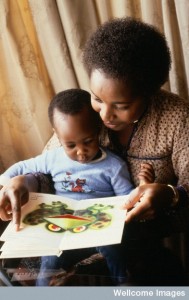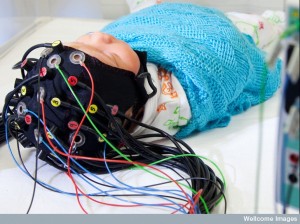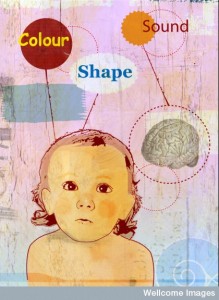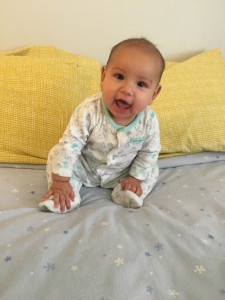 What do infants know? Are infant cognitive abilities innate based on brain structure or learned? Recent research shows that infants have surprising mental abilities, despite their inability to move. Infants learn languages better than adults. Infants are not as good as adults with numbers but start with much more math ability than previously thought. It has been difficult to find out how much they know until recently because they can’t tell us.
What do infants know? Are infant cognitive abilities innate based on brain structure or learned? Recent research shows that infants have surprising mental abilities, despite their inability to move. Infants learn languages better than adults. Infants are not as good as adults with numbers but start with much more math ability than previously thought. It has been difficult to find out how much they know until recently because they can’t tell us.
Infants know much more than they are able to say or gesture. At six months old they start to show lots of signs of development and can begin to use more advanced play equipment. For example, you can safely put them into a baby swing chair and they’ll be entertained while you get on with other things. They make sounds; then they babble; then words usually appear at one year and large vocabulary at two. Reading and listening to books and kids stories can encourage the talking process very well. Despite motor difficulties, recently, infants have been shown to receive and understand much more information than had been considered. This research has found several major areas of language development in infants.
 Infants, also, understand how objects interact with each other, as well as people and their behavior and goals. They understand the geometrical relationship of forms. Surprisingly they understand the notion of communication, probabilities and the fact that others have mental states. All of these skills start immediately at birth and gradually become greater.
Infants, also, understand how objects interact with each other, as well as people and their behavior and goals. They understand the geometrical relationship of forms. Surprisingly they understand the notion of communication, probabilities and the fact that others have mental states. All of these skills start immediately at birth and gradually become greater.
This post will address new research into remarkable cognitive abilities in infants. Also, included at the end is a summary of other recent findings of abilities at later ages of childhood. These findings might benefit methods of education (for more details see a previous post Can Neuroscience Help Education?).
Response to Complex Sound Combinations
Long before word production, infants respond to sounds and complex sound combinations used in their parent’s language. They are aware at birth of the sounds used in their language and begin to make similar sounds. They start with the vowels and then later the consonants. After this, they put together the particular phoneme combinations that are used in their particular language.
Aware of Abstract Word Relationships
Infants are aware of the abstract relationships between types of words. They understand words related to functions (most often verbs) and understand the most important ones in their language by six months. They emphasize particular syllable structures that are more often used by seven months. At one year, infants understand that function words are different than nouns. They, also, understand that suffix syllables (sounds attached to a word that alters its meaning such as gender) are different than nouns. In linguistics, function words and suffixes are called a closed group since there are a limited number of them. Nouns, on other the other hand, are called an open group since there are an unlimited number of new words.
Infants seem to understand this distinction between closed and open word groups. Infants, also, understand the basic sounds that make up words (called morphemes). Before they can make sentences at age 2, they understand when others make mistakes with ungrammatical speech. Then they start making full sentences.
Infants Understand Words Correspond to Things
 Very early on, infants know that words correspond to particular things. By six months they are learning words that have particular meaning, such as “mommy”, “foot” and “hug”. At six months they will look at the particular objects on a computer screen in response to the word. At one year they know approximately 50 words.
Very early on, infants know that words correspond to particular things. By six months they are learning words that have particular meaning, such as “mommy”, “foot” and “hug”. At six months they will look at the particular objects on a computer screen in response to the word. At one year they know approximately 50 words.
If given examples of pictures of particular animal classes, infants associate words in these categories at three months. Labels of objects are much easier for them to learn than other tasks. By 14 months many objects can be retained in a special working memory for language.
By three years they can use object names to understand grammar. In experiments if they are taught nonsense sounds related to categories, they are surprised later if these sounds are used differently. Therefore, they understand both verbs for actions and nouns for objects differently. All of the studies showing these results are done in several minutes with infants and with no training.
Statistically Analyze Speech
Infants appear to have the ability to statistically analyze speech patterns to find the basics of their home language. They, also, use this to understand the rhythm of producing a flow of words in their language. They quickly figure out that syllables can relate to each other even if they are not next to each other. Remarkably, this statistical approach seems to allow them to understand what are words and what they refer to.
Statistical Discovery Theory for Infants
 What separates human infants from intelligent animals in their statistical discovery is their finding many different levels of information mentioned at the same time. They, also, readily discover what speech from them will trigger in the behavior of the adults. For infants to discover the meanings of their action words (verbs), they understand the similarities of the short syllable sounds in all of the verbs used. They, also, are able to find the sounds related to visual objects, particularly those that occur very frequently.
What separates human infants from intelligent animals in their statistical discovery is their finding many different levels of information mentioned at the same time. They, also, readily discover what speech from them will trigger in the behavior of the adults. For infants to discover the meanings of their action words (verbs), they understand the similarities of the short syllable sounds in all of the verbs used. They, also, are able to find the sounds related to visual objects, particularly those that occur very frequently.
From their statistical approach, infants are only able to learn specific types of sound patterns. Because this learning is limited, there is a question as to whether it is related to the structure of particular brain circuits.
Abstract Patterns
At 7 months, infants rapidly learn the abstraction of the relation of three syllables in a word. Examples include words made of three syllables where the first syllable is repeated immediately after the first – aab – and where the first syllable is repeated after a different one – aba. Infants are able to learn this and relate it immediately to other similar words. They are, then, able to abstract this knowledge involving a hierarchy of word types. After being accustomed to a sentence of three words with the last two the same – aba abb abb. they understand and looked longer at the altered sentence abb abb aba. They failed where the similarities are not close together but separated.
 Speech is uniquely available to infants possibly from a brain structure that allows them to understand these embedded structures of syllables.
Speech is uniquely available to infants possibly from a brain structure that allows them to understand these embedded structures of syllables.
Abilities with math are not as developed, but better than previously thought. Infants can understand algebra relationships between words that are associated with objects. Infants have the ability to abstract and possibly understand recursive rules, that is, specific rules of ordering objects.
Associations were thought to be in the “associate regions” of the cortex. But, it is now known that most regions are multisensory, so associative events occur throughout the brain. It is not clear if long circuits including the frontal lobes are part of the ability to use abstractions with great associations. (Discussed more later).
Learning Numbers
When do infants have the ability to use symbols for abstract concepts? Children don’t use abstract numbers until four to ten years of age. But, they do eventually learn this in all human cultures. Infants, and animals, have some representation of numbers.
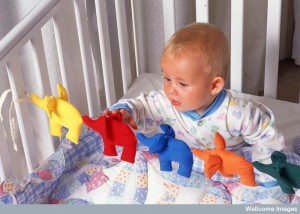 Infants can distinguish the difference between four and twelve repeated syllables and also visual representations correlated with the sounds. This implies understanding of the abstract concept of number across sound and sight. A set of findings shows that infants already have some abstraction ability, which is more prominent in older babies, adults and many adult animals, such as birds, fish, primates and rodents. Recent findings related to abstractions in infants includes:
Infants can distinguish the difference between four and twelve repeated syllables and also visual representations correlated with the sounds. This implies understanding of the abstract concept of number across sound and sight. A set of findings shows that infants already have some abstraction ability, which is more prominent in older babies, adults and many adult animals, such as birds, fish, primates and rodents. Recent findings related to abstractions in infants includes:
- Infants can only distinguish some ratios. The ratio has to be at least a three to two ratio to be noticed. As they age, the ratio that they can notice becomes smaller.
- Infants can use elementary addition and subtraction and they are able to compare numbers and orders.
- Infants’ sense of number is linked to understanding of length of a line. They can correlate adding more objects arranged in an order to that of making a line longer.
- As babies grow, their idea of how many numbers there are increases.
- When infants look at groups, their ability to understand the number of objects is disturbed by attention to a particular member of the group. If the number of objects is small then they usually attend to the individual in the group and not the number.
Babies begin to learn words for numbers at age three or four. Baby’s first number words are used approximately. The earlier ability to have approximate understanding of numbers gradually changes to detailed words for exact numbers. If children first think of the numbers of specific objects, they then are better able to learn exact number words. They are, also, more able to learn other math skills. This goes along with the previous finding that learning words for size and shape helps skills in math and science. Therefore word learning and number learning are linked.
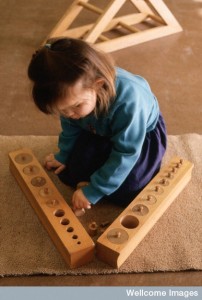 By four or five, most children understand exact numbers and counting. They can understand the equality of different objects with the same number. They understand that adding a similar object to a group changes the number. Young children understand that taking one of the members away and then putting it back doesn’t change the overall number. They don’t yet understand that adding a similar object and taking away a different object affects the abstract number amount in the same way. Therefore, older children understand the abstract concept of the number and the younger do not.
By four or five, most children understand exact numbers and counting. They can understand the equality of different objects with the same number. They understand that adding a similar object to a group changes the number. Young children understand that taking one of the members away and then putting it back doesn’t change the overall number. They don’t yet understand that adding a similar object and taking away a different object affects the abstract number amount in the same way. Therefore, older children understand the abstract concept of the number and the younger do not.
The abstract sense of equality of numbers of objects occurs at the same time as the understanding of words for exact numbers. This is another reason to think that language and math skills are linked. Even in societies with fewer general words, they all have the same understanding of words for numbers. Deaf children living with others who can hear are less able to understand number words.
What are Brain Structures For Language and Math?
What are the unique brain structures in humans that allow greater abilities than other animals? Almost all of the capacities exist to some degree in other animals. Without careful instruction, human infants learn a natural language and a system of numbers within four years. Human infants understand multiple levels of language and speech and link concepts and objects to words. They gradually develop their concepts to be abstract. Their understanding of language and math are related and grow together. But, all infant studies are very difficult because of lack of intense training for infants, lack of verbal instructions and distractable attention. MRI findings of infants are inexact because of changes young brains are undergoing as well as all the other limitations (see post on Limitations of MRIs for Understanding Behavior)
Can current science show how these unique characteristics occur because of brain structures? It is not clear how why these unique infant brain regions occur.
Brain Development
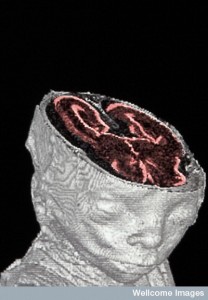 In the last trimester, neuron migration is completed; connectivity is set up in neuronal networks; and unique gyri form (see post). In the 32nd week, all six layers of the cortex are set up. At first, connections are temporary and then very large relocations occur. A previous post described how first there are patterns of electrical synapses and then chemical synapses are built on top of this structure.
In the last trimester, neuron migration is completed; connectivity is set up in neuronal networks; and unique gyri form (see post). In the 32nd week, all six layers of the cortex are set up. At first, connections are temporary and then very large relocations occur. A previous post described how first there are patterns of electrical synapses and then chemical synapses are built on top of this structure.
Specific connections with the thalamus increase the sensory input. Then, the excitatory pyramidal neurons are in place. And then the inhibitory interneurons arrive that control the cortex pyramidal neurons. The specific interneurons of learning (parvalbumin) start at this time and gradually grow through several months after birth. In this third trimester, the typical connectivity patterns are set up—hubs with massive short-range connections and massive long-range connections.
Groups of connections are made before birth. The brain continues to grow for two years, intensely for the first six months of life (0.4 mg per week). The first three months show extreme metabolic ability with creation of large numbers of synapses. There are axons growing all over the brain. Myelin starts forming (goes on for twenty years) and cortex columns widen with more and more synapses. Some regions myelinate rapidly such as the visual cortex, while the auditory takes years. Frontal regions take decades, except rapidly in the more associative regions.
Surprisingly, specific regions rapidly develop in hierarchies and long-range connections between frontal, parietal and cingulate creates large network.
Studies previously have shown that first there is development in primary sensory areas not the higher analysis regions. This has led to the view that the infant brain starts with concrete sensory information, which gradually becomes abstract in thoughts.
However current research shows greater complexity.
- A fully complex brain organization occurs rapidly in the last trimester.
- Frontal regions are active in infants.
- Asymmetries of the right and left side of the brain occur in infants.
Since these unique brain structures occur without experience guiding them, it is not known why they are built so early.
Early Brain Organization
Recent studies (EEG and BOLD) show activity in primary sensory regions and the resting state default mode networks in the last trimester. Therefore, what is often thought of, as the identity centers are active in the newborn infant along with connections between right and left sides of the brain. Unfortunately, there is little known about the glia and vessels of the infant.
This definite infant brain organization suggests a unique structure for learning at birth. Stimulating sensory data travel in specific circuits, not just the random circuits previously thought. For example, infants and adults, both calculate sounds that make up words differently than other auditory information. Studies show that infants respond to specific sounds by different speakers. Similarly, infant response to language based syllables and number of objects has unique regions. Six month olds have particular imaging responses to particular arrangements and shapes and numbers of objects. Specific regions responded to changes in shapes.
This new research points to particular structures for speech, numbers and understanding of objects in infants. From the very first response to the outside world, specific stimuli have unique processing and circuits.
Frontal Regions in Infants
Most neuroscientists have thought the frontal lobes of infants are not yet connected. See the post on the frontal lobes for details of this vast and complex region. One sub region of the frontal lobe—the frontal pole—myelinated early in the infant, before other regions. Very recently, inferior frontal regions are noted to mature, also in the infant. Frontal regions and circuits are actually part of networks from third trimester on. It is not the entire frontal lobe that develops as in adults, but particular smaller regions for the particular language, math and object understanding.
These frontal regions might be the basis of the early abstraction ability of the infant. Therefore, the theories that assumed only bottom up early development do not appear to be correct. There clearly is early top down abstraction ability and connections of concepts. How much multi leveled hierarchical learning occurs in infancy is not yet known. But, new research shows definite top down modulation of sensory data. A hierarchy of different types of responses has been demonstrated.
Left Right Asymmetry in Infant Brains
In adults much of language is correlated with the left side of the brain and social understanding the right. Anatomically in infants, there are, also, differences in the right and left brain—right hemisphere above and in front of the left. There are other specific differences. Both handedness and language show more activity on left. These brain differences exist before the infant can move and are not from activity. Sulci appear weeks earlier on the right side and the right has more blood flow at rest. There appears to be quicker maturation on the right in various regions.
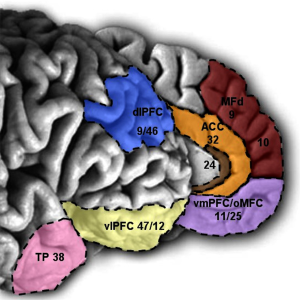
But, some regions that are related to understanding language sounds—arctuate fasciculus, area 44 and posterior superior temporal sulcus—all mature faster on left.
By three months, they provide special language-working memory of several seconds to remember language sounds. Even though other memory regions may not be developed, this special working memory center allows keeping words in mind long enough to understand sentences. Left regions for speech are better on the left from birth. By six months speech centers are much more developed including more active genetic networks.
Studies of these brain regions are consistent, also, with the development of strong relationship of language with understanding numbers. For using arithmetic, the infant has a more asymmetrical brain than adults. This strongly goes against the notion that the sides are equal at birth and become lateralized later. It is not clear how this difference from other animals occurs.
What Do Infants Know
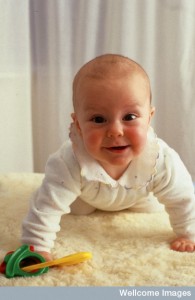 Infants have many complex cognitive abilities with specific networks already working that are involved in higher-level understandings. This occurs even in the third trimester fetus. The specific regions are similar to the adult, but more specific. There are, also, many different individual rates of development for these regions. Temporal differences in each brain region might help determine what abstractions can occur and might be part of statistical learning.
Infants have many complex cognitive abilities with specific networks already working that are involved in higher-level understandings. This occurs even in the third trimester fetus. The specific regions are similar to the adult, but more specific. There are, also, many different individual rates of development for these regions. Temporal differences in each brain region might help determine what abstractions can occur and might be part of statistical learning.
Infants, already, have a very complex brain architecture that has reactions with exact patterns from the third trimester. These functions are in many different areas, but very specific to later functions. Learning occurs at many levels not just bottom up. Learning occurs immediately at higher levels of organization.
Humans master an evolving number of symbol patterns starting with words and language. Infants already start the development of abstractions of many types. The infant brain is further developing these capacities gradually. As these capacities are understood, hopefully, new education approaches can be developed.
Mental events are known to strengthen synapses for neuroplasticity and to determine pruning of synapses. Does the mind, also, determine these early highly developed brain regions in infants?
Summary of Childhood Data
 While it is premature to prescribe specific teaching methods for infants and children from the current neuroscience, there is no doubt that they are much more intelligent and aware than previously thought.
While it is premature to prescribe specific teaching methods for infants and children from the current neuroscience, there is no doubt that they are much more intelligent and aware than previously thought.
Clearly, it is advisable to speak intelligently to infants and children—using larger vocabulary, gesturing to emphasize the meaning of new words, and allowing their natural scientific enquiry to be prominent rather than excessive structure.
The more words they learn the better. Words related to size and shape help science ability later. Children, also, learn from movement related to the conversation. Infants often pay attention to new objects but can’t take that attention away from the object easily. Infants understand trustworthy and untrustworthy people. They understand immediate rewards, but not delayed rewards.
The following is a summary of recent findings including older children:
- 4 month olds process faces as adults, while other images lag behind (research through imaging)
- 5 month olds are able to track causes of sounds and actions. Older children can observe more subtle causal relations. They make these correlations with small sample size.
- At age 6 months, infants distinguish two languages they do not know by looking at the speaker’s face. They are better at this if in a bilingual household.
- By 6 months infants know their names and names of parents, but also words for food and body parts.
- 9 month olds can tell which adults are friendly and unfriendly
- 14 month olds will mimic an unusual event if it is accompanied by an unusual word.
 Children 14 to 18 months learn words better with more parental talk using more words. Also, they learn more words when adults give non verbal cues as they use words.
Children 14 to 18 months learn words better with more parental talk using more words. Also, they learn more words when adults give non verbal cues as they use words.- 8 month olds could not transfer knowledge to new situations but 16 months olds could.
- Infants 16 o 18 months old can predict the actions of others for goal directed behavior and can detect what the goals are and their future behavior. By tone of voice they could tell purposeful actions and accidents (“whoops” and “there”)
- 2-year-old children understand complex grammar before being able to speak sentences—much more than they can say (research using words and cartoons).
- 3 year olds can old 1.3 objects in working memory, 4 year olds 1.8 and adults 3 to 4 (via brain imaging)
- Children at age 3 understand that man made objects can be owned but objects from nature can not
- By 4.5 years children show high-level executive functions including planning, monitoring, task switching, and attention. Training that helps adolescence at this age could include having children help plan activities, and impulse control exercises such as thinking before taking an action (longitudinal study till age 15)
- More vocabulary at 4.5 increases thinking skills in adolescence (longitudinal study till age 15).
 6 year olds understand when they are only told part of the truth. They, also, prefer teachers who do not spend time teaching what they already know, or what they can already infer.
6 year olds understand when they are only told part of the truth. They, also, prefer teachers who do not spend time teaching what they already know, or what they can already infer.- Sense of body is different in children and adults and at different ages based on different neural pathways developing in different sequences – one through seeing a hand touching us and one just seeing. (via sensory illusion)
- Young children use intuitions and expectations about possible outcomes. They analyze situations and eliminate unlikely possibilities.
Math and Science Training
- To teach children numbers, don’t say “look at three bears” because they don’t know what three is. First say “look at the bears,” then “there are three”. They can then figure out what a number is.
 Intensive math learning in second grade led to alterations in brain regions related to numbers that later helped math.
Intensive math learning in second grade led to alterations in brain regions related to numbers that later helped math.- If children ages 1 to 4 years learn more words about size and shape, their science ability is greater later in life.
- Using gestures while learning helped children with arithmetic. This can also increase abstract learning.
- Children as young as 2 years old are like little scientists, comparing hypotheses and data, making inferences about causation. Children experiment by watching and listening others and use statistics to reason. This implies that structured early learning is not the best way, but rather experimentation and reasoning from data.

